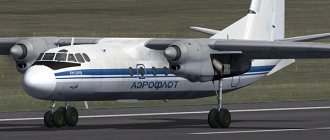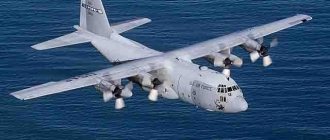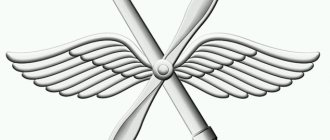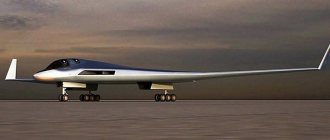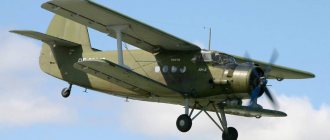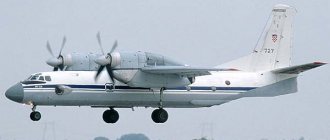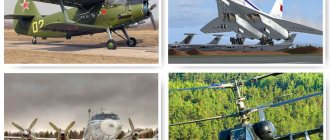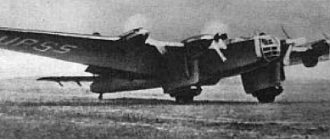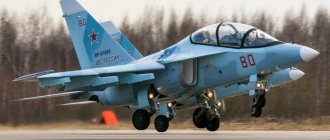The request "Military transport aviation of the Russian Federation" is redirected here. A separate article should be created on this topic.
| Military Transport Aviation Command | |
| Air Force flag | |
| Years of existence | December 1, 2010 - present V. |
| A country | Russian Federation |
| Subordination | Main Command of the Russian Air Force[1] |
| Included in | Russian Air Force |
| Type | air unit |
| Function | to solve strategic (operational-strategic), operational and operational-tactical tasks in theaters of military operations (strategic directions)[2] |
| Dislocation | Russian Federation |
| Participation in | CSTO operation in Kazakhstan, Russian military operation in Syria, extinguishing forest fires in Siberia, Second Chechen War |
| Marks of Excellence | |
| Commanders | |
| Acting commander | Lieutenant General Vladimir Benediktov |
| Notable commanders | see list |
Military Transport Aviation Command
, the former 61st Air Army of the Supreme High Command (
abbr.
61 VA VGK) is an operational-strategic association of the Russian Air Force,
military transport aviation
of the Russian Armed Forces. Formed on December 1, 2009 on the basis of the 61st Air Army of the Supreme High Command. The command office is located in Moscow.
Commander of Military Transport Aviation - Lieutenant General Vladimir Benediktov (appointed to the post on January 7, 2013).
Description[ | ]
Military transport aviation is the means of the Supreme Commander-in-Chief of the Armed Forces of the Russian Federation. Designed to solve strategic, operational-strategic, operational and operational-tactical tasks in theaters of military operations and strategic directions.
Military TA includes Military Transport Aviation
(VTA) and transport aviation as part of other associations and formations of the Russian Air Force (VKS).
The main tasks of military transport aviation are: landing units of the Airborne Forces from operational airborne assault forces; delivery of weapons, ammunition and materiel to troops operating behind enemy lines; ensuring the maneuver of aviation formations and units; transportation of troops, weapons, ammunition and materiel; evacuation of the wounded and sick, participation in peacekeeping operations.
Over the last half century, in addition to the military air transport fleet itself, most military airfields (aviation military units) have one or two military transport aircraft (helicopters) on staff for emergency delivery (transportation) of personnel (the so-called “delivery”).
By decision of the leadership of the Russian Ministry of Defense, it is also used to extinguish natural fires in the country.
Until 2011, there was also transport aviation as part of other associations and formations of the Russian Air Force. Previously, transport aviation existed as part of other types of armed forces - the Navy, the Strategic Missile Forces, and so on, but in 2009-2011. it was transferred to the Air Force.
At the beginning of 2013, the General Staff approved a four-row structure of military transport aviation[3]:
- a light military transport aircraft (payload 6 tons) is currently represented by the An-26;
- a medium military transport aircraft (payload 20 tons) is currently represented by the An-12;
- a heavy military transport aircraft (payload 60 tons) is currently represented by the Il-76;
- a super-heavy military transport aircraft (payload not strictly defined) is currently represented by the An-124.
Military Transport Aviation Day is celebrated annually on June 1.
An-124
The An-124 is a Soviet cargo aircraft developed by the Antonov Aviation Design Bureau. The aircraft was positioned as a super-heavy aircraft, and was capable of transporting up to 160 tons, depending on the number of engines (four or six). The maximum flight speed of this device was 865 kilometers per hour. The fuel supply was enough to cover up to 4,800 kilometers at maximum load. A large number of different modifications were made, the most famous of which was presented as a carrier for the Buran. A total of 55 such devices were manufactured, the average cost of one unit is $300 million.
Composition[ | ]
For 2015
- 12th Military Transport Aviation Division - Tver (Migalovo): An-124, An-124-150, Il-76MD, An-22, also including:
- 117th Military Transport Aviation Regiment - Orenburg (Orenburg-2): Il-76MD, An-12
- 708th Military Transport Aviation Regiment - Taganrog (Central): Il-76MD
- 334th Guards Berlin Military Transport Aviation Regiment - Pskov (Crosses): Il-76MD, Il-78, Il-76MD-90A
- 144th aviation regiment of long-range radar detection aircraft - Ivanovo-Severny: A-50, Il-76MD
- 8th military transport aviation regiment of refueling aircraft - Tver (Migalovo): Il-76/78, An-22, An-26, An-12.
- 235th VTAP (military transport aviation regiment)
- 566th Solnechnogorsk Military Transport Aviation Regiment - Seshcha: An-124, An-124-100[4]
In addition to the listed formations and units, the VTA includes air bases, units and units of special forces.
IL-76
The Il-76 was developed by the Soviet Ilyushin Aviation Design Bureau. The cargo plane first took to the skies in 1971, three years later it was put into operation, and continues to be used to this day. During the years of the USSR, it was the first cargo aircraft equipped with turbojet engines, which allowed it to fly at a maximum speed of more than 770 kilometers per hour. The device was capable of transporting cargo weighing up to 60 tons over distances of up to 4,200 kilometers. Initially, the aircraft was used to transport troops over long distances. With a two-story fuselage layout, the aircraft is capable of transporting up to 225 people. Today, the Il-76 is used to transport cargo, its average cost is $28 million.
Equipment and weapons[ | ]
As of 2009 included:
| Type | Production | Purpose | Quantity | Notes |
| Aircraft | ||||
| Il-76MD | USSR | Military transport aircraft | 118 units[5] | |
| Il-76MD-90 | Russia | Military transport aircraft | 1 unit[5] | |
| An-124 | USSR | Military transport aircraft | 22 units[5] | |
| An-124-150 | Russia | Military transport aircraft | 1 unit[5] | |
| An-12 | USSR | Military transport aircraft | 10 units[5] | |
| An-22 | USSR | Military transport aircraft | 7 units[5] | |
| A-50M | USSR | AWACS | 18 units[5] | |
| A-50U | Russia | AWACS | 2 units[5] | |
VTA commanders: Lieutenant General V.V. Benediktov, Aviation Colonel General V.V. Efanov, Lieutenant Generals V.F. Denisov and V.T. Kachalkin. 2022
An-22
The An-22 is the largest turboprop aircraft in the world. The cargo vehicle was equipped with four turboprop engines, which allowed it to reach a maximum speed of 650 kilometers per hour. The fuselage length was 64 meters, the wingspan was 57 meters. The crew consisted of five to seven people, three of whom were pilots. The maximum load capacity of this unit is 60 tons. A fuel reserve of 96 thousand kilograms allows the transporter to travel up to five thousand kilometers. A total of 69 such devices were produced.
Design Features
Due to the fact that large internal space is required to accommodate military equipment and manpower inside transport aircraft, the airframe design has one feature. To load equipment, the design of transport vehicles must include a loading hatch. It can be located in front, under the cockpit, or in the rear of the fuselage.
By 1955, a set of requirements for the design of military transport vehicles had formed:
- cantilever high-wing aircraft with swept wings;
- two or four turbojet engines on pylons under the wings;
- cargo hatch at the rear (less often at the front) of the fuselage;
- load capacity – at least 20 tons.
In the mid-twentieth century, transport workers were equipped with piston engines. They were replaced by more modern, turbojet ones. The number of keels is one or two. The airframe is made of high-strength sheet steel or titanium alloys. The cross-section of the fuselage of most transport aircraft is round.
Some of the modern heavy vehicles have a pear-shaped fuselage. The multi-legged chassis of transport workers must ensure landing on unsuitable ground areas.
An-70
The An-70 is a military transport aircraft that entered service in 2015. The aircraft is designed to transport cargo weighing up to 70 tons over distances of up to 1,200 kilometers. The maximum speed of the aircraft is 700 kilometers per hour. The aircraft is produced in Ukrainian serial production in Ukraine. The cost of the aircraft is $67 million.
Military transport aviation in the pre-war and war years
During the period of the Versailles restrictions, Germany produced so many transport aircraft that even after converting some of the civilian aircraft into military aircraft, there were enough transport aircraft left to provide air supply to the German motorized units breaking through behind enemy lines. This became an important element of the “blitzkrieg” (German: “lightning war”) tactics.
"Douglas" DC-3 (Li-2). 1935/1939 USA–USSR
The most popular transport aircraft of the Luftwaffe (German Air Force) was the Ju-52/Zt created in 1931. This slow, corrugated aircraft served as a bomber in the Spanish Civil War, and by 1939, with the Germans having real bombers, the Ju-52 was returned to being a "truck." The USSR lagged behind in the development of transport aviation - resources were spent on creating combat vehicles. Tupolev's experimental 8-engine aircraft "Maxim Gorky" (ANT-20), , crashed in 1935 and was not produced afterwards. In 1939, they began licensed production of the American twin-engine Douglas DC-3 , under the brand name Li-2 . He became the main Soviet transport worker during the war.
Dropping parachute troops was dangerous: the paratroopers were easy to spot and shoot from the ground, the wind could scatter the paratroopers, and the scattered group had a hard time in battle. The fully equipped paratrooper was too heavy for the parachute, and his weapon became tangled in the lines. Therefore, in the 1940s. weapons and equipment were dropped in separate parachutes in bags, and if they were not found in time, they had to fight with what they had on them - pistols, knives and grenades. The landing method was more reliable than the parachute method, but there were not convenient landing sites everywhere, and planes often crashed upon landing. A technical solution was required to ensure a safe landing in any conditions.
"Junkers" Ju-52/Zm (1931 Germany), towing glider DFS 230 (1937 Germany)
At the end of the 1930s. The Germans began to use gliders towed by transport aircraft, such as the DFS 230 . This plywood landing craft was usually towed by a Ju-52 . After takeoff, the DFS dropped the unnecessary landing gear - it sat down “on its belly.” It usually failed when landing, but the loss of a cheap car was acceptable. In 1940, German paratroopers landed on the DFS and captured Fort Eben-Emal, which covered the Belgian border. Light DFS could not transport many people and heavy weapons. Therefore, already in 1941, a heavy glider Me-321 “Giant” for 120 paratroopers or 20 tons of cargo. He could even transport a tank. The glider turned out to be so successful that on its basis they created the Me-323 , which could lift 23 tons. The German experience inspired England to build the heavy Airspeed AS.51 , and the Waco CG-4A .
In armies, airplanes carried out “foreign” tasks when necessary. Fighters attacked ground targets, high-altitude bombers and attack aircraft replaced fighters, dive bombers bombed from level flight, transport aircraft served as bombers and vice versa, and almost everyone conducted reconnaissance. But specialized reconnaissance aircraft were also built. One of the most popular and successful was the light twin-engine reconnaissance spotter Fw 189 of 1940. This maneuverable and survivable twin-boom vehicle was a difficult target for fighters. The cockpit, glazed even from below, allowed the pilot to clearly see targets on the ground, aiming bombers at them and adjusting artillery fire. The Germans nicknamed the Fw 189 the “flying eye,” and our soldiers called it the “frame” because of the shape of the fuselage. The appearance of the “frame” meant that the enemy would soon launch a bomb or artillery strike.
The Me-321 "Giant" glider lands troops
Transport aircraft Me-323. 1941 Germany payload – 23,000 kg, flight range – 800 km
"Arado" Ar.232. Germany. 1940 payload – 8400 kg, flight range – 1062 km
An-26
The An-26 is a Soviet transport aircraft developed at the Antonov Design Bureau. It first took to the skies in 1969 and was put into operation a few years later. The maximum carrying capacity of this transporter is five and a half tons with a maximum fuel load. A reserve of five tons of fuel is enough to cover up to 1,200 kilometers at maximum load. Two turbofans allow the aircraft to reach a maximum speed of 540 kilometers per hour. The aircraft was produced from 1969 to 1986; a total of 1,400 of these aircraft were produced.
An-32
The An-32 was developed by the Soviet Antonov Design Bureau and was positioned as a military transport aircraft. The first flight of the device took place in 1976; a total of 360 such devices were produced. The maximum load that this device can lift is just over six tons. A fuel reserve of five and a half thousand kilograms allows the transporter to cover distances of up to 780 kilometers. The length of the aircraft is 23 meters, the wingspan is 29 meters. The cost of one unit is $15 million. In 2010, the Antonov Design Bureau released a modification of this aircraft with improved flight characteristics. Now, the aircraft has modern equipment and avionics on board, as well as modified and improved engines.
Russian transport aviation is developing every day. Today, several cargo aircraft are being actively developed that will be capable of transporting large amounts of cargo over long distances. It is planned to use these devices for military purposes as a replacement for previous devices.
